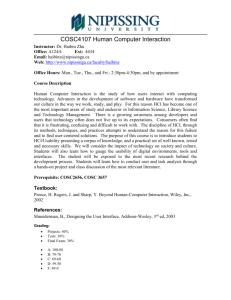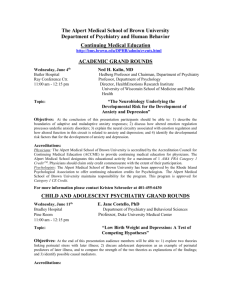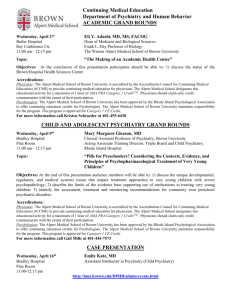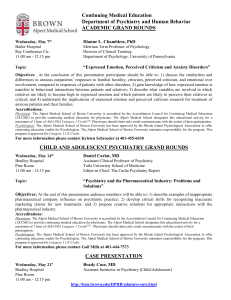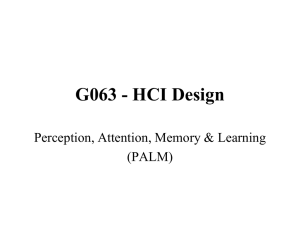Getting Organized - School of Computing
advertisement
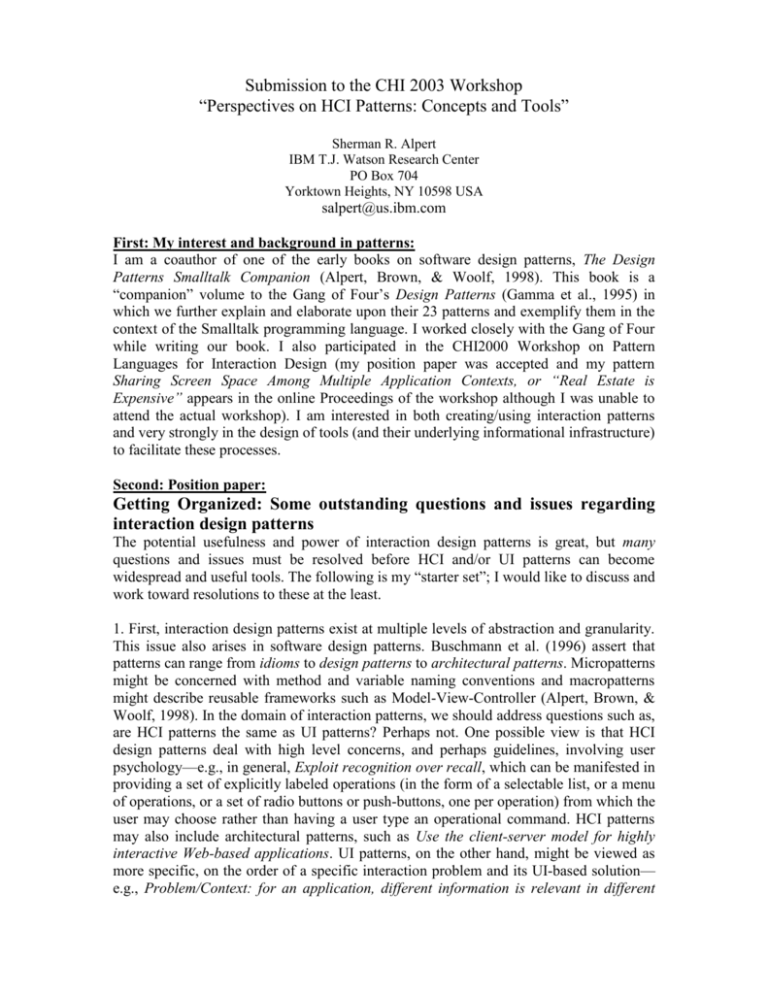
Submission to the CHI 2003 Workshop “Perspectives on HCI Patterns: Concepts and Tools” Sherman R. Alpert IBM T.J. Watson Research Center PO Box 704 Yorktown Heights, NY 10598 USA salpert@us.ibm.com First: My interest and background in patterns: I am a coauthor of one of the early books on software design patterns, The Design Patterns Smalltalk Companion (Alpert, Brown, & Woolf, 1998). This book is a “companion” volume to the Gang of Four’s Design Patterns (Gamma et al., 1995) in which we further explain and elaborate upon their 23 patterns and exemplify them in the context of the Smalltalk programming language. I worked closely with the Gang of Four while writing our book. I also participated in the CHI2000 Workshop on Pattern Languages for Interaction Design (my position paper was accepted and my pattern Sharing Screen Space Among Multiple Application Contexts, or “Real Estate is Expensive” appears in the online Proceedings of the workshop although I was unable to attend the actual workshop). I am interested in both creating/using interaction patterns and very strongly in the design of tools (and their underlying informational infrastructure) to facilitate these processes. Second: Position paper: Getting Organized: Some outstanding questions and issues regarding interaction design patterns The potential usefulness and power of interaction design patterns is great, but many questions and issues must be resolved before HCI and/or UI patterns can become widespread and useful tools. The following is my “starter set”; I would like to discuss and work toward resolutions to these at the least. 1. First, interaction design patterns exist at multiple levels of abstraction and granularity. This issue also arises in software design patterns. Buschmann et al. (1996) assert that patterns can range from idioms to design patterns to architectural patterns. Micropatterns might be concerned with method and variable naming conventions and macropatterns might describe reusable frameworks such as Model-View-Controller (Alpert, Brown, & Woolf, 1998). In the domain of interaction patterns, we should address questions such as, are HCI patterns the same as UI patterns? Perhaps not. One possible view is that HCI design patterns deal with high level concerns, and perhaps guidelines, involving user psychology—e.g., in general, Exploit recognition over recall, which can be manifested in providing a set of explicitly labeled operations (in the form of a selectable list, or a menu of operations, or a set of radio buttons or push-buttons, one per operation) from which the user may choose rather than having a user type an operational command. HCI patterns may also include architectural patterns, such as Use the client-server model for highly interactive Web-based applications. UI patterns, on the other hand, might be viewed as more specific, on the order of a specific interaction problem and its UI-based solution— e.g., Problem/Context: for an application, different information is relevant in different contexts, i.e., orthogonal sets of information must be shown, using different screen layouts, depending on mode or context or task and there is not enough screen real estate to display simultaneously all the information relevant to all contexts; Solution: the “Sharing Screen Space” pattern (see Alpert, 2000). The Sharing Screen Space pattern offers specific UI solutions to the problem. Is the HCI pattern Exploit recognition over recall fundamentally different than the Sharing Screen Space design pattern? And is there such a thing as an “idiom” in the interaction patterns world? The main questions then are: What chunk of knowledge—at what grain size—is appropriate to “qualify” as an independent pattern? What constitutes an HCI pattern; what precisely defines a UI pattern—how are they the same, different? 2. Next, What are the scenarios of use—how do we envision HCI and UI design patterns being used? When would a UI designer consult a PatternsBase (a database of design patterns)? Why? How should DPs be organized in the PatternsBase? If patterns are accessible/editable by a computational tool, how are DPs indexed in the PatternsBase; how would a user search for/find appropriate patterns for a particular situation? The rationale behind deriving scenarios of use is that a reasonable set of use scenarios is necessary to drive the design of design patterns tools. 3. Another (continuing) question is, What information or knowledge necessarily must be included in the pattern? This has been addressed in other patterns workshops, but I do not believe the question is resolved— and this issue has strong implications for the design of patterns tools. Such resolution (if any) may also be (partially) driven by tool use scenarios. As one example, if one use scenario is, “I have application X that has problem/context/situation P; what design pattern can be applied to solve or address P?” then interaction patterns ought to include an Applicability section as do the Gang of Four software design patterns. I’ve seen many interaction patterns that do not include such a section. An Applicability section specifies in specific terms when a pattern should be considered as a solution. For example, the Applicability section of a software design pattern might say, Use the Adapter pattern when you want to use an existing class, and its interface does not match the one you need you want to create a reusable class the cooperates with unrelated or unforeseen classes, that is, classes that don’t necessarily have compatible interfaces… (Gamma et al., 1995, p. 140). For a UI design pattern, an Applicability section might appear as: This pattern applies when …: 1. A single application has multiple contexts, states, tasks, or user informational needs. 2. Each of these contexts requires the user to interact with UI elements that are relevant to that context alone, but: 3. We don’t want to overwhelm or confuse the user with a window that simultaneously displays all UI elements relevant to all contexts, including those not relevant to the application’s or user’s current context … (Alpert, 2000, p. 3). This information need not necessarily reside in a section precisely named Applicability— there is no need to be totalitarian about pattern contents—but a major benefit of incorporating this information in a specific section has to do with interaction pattern tools: the information in the Applicability section would be useful for indexing patterns and supporting search processes (the ability to find applicable/appropriate patterns for a particular context/situation/problem). 4. We should also ask the question, “Can the use of DPs stifle creativity?” This may also be somewhat dependent on usage scenarios, for example just how and when UI design patterns will be used by designers. Once an appropriate pattern (“solution” to a design problem) is found, will it be used as is or improvised upon? Here’s a concrete example: in an intelligent tutoring system for elementary algebra (Alpert, Singley, Fairweather, 1999), we needed a way to show an equation, a way to select a term or terms in that equation, a way to select an algebraic operation to work on the selected term(s), a “give me a hint” button, etc. If we had simply consulted a pattern language or PatternsBase of UI patterns and strictly followed its advice/solution, the UI might have looked like the following [menus for operations, tabbed pages to share screen space, text fields for the equation and hints]: or the following [sets of normal buttons for operations, tabbed pages to share screen space, text fields,]: The above UIs are certainly usable, but are also rather drab. This application was intended to be used by middle school students who might require something more motivating, stimulating. The actual implementation looked like the following; the “paper” buttons on the corkboard crunch (and make a crunching sound) when clicked, the animated interface agent dances, applauds, etc. and can be clicked on to ask for hints. This UI is more interesting and aesthetically pleasing. But would design patterns “lead” me to such a solution? 5. Another issue to consider: Are HCI/UI design patterns different for different targets (platform, operating system)? In The Smalltalk Companion (Alpert, Brown, & Woolf, 1998), for example, we point out how and why many of the Gang of Four’s patterns change significantly when the target language is Smalltalk as opposed to the C++ implementations portrayed in the original Design Patterns (Gamma et al., 1995). Martijn van Welie has nicely organized interaction patterns in three categories based on target environment: GUI, Web, and mobile (see http://www.welie.com/patterns/) – are these categories sufficient? How about 3270 green screens? Should patterns be categorized by target? 6. Lastly, the notion of anti-patterns may be very useful for the HCI community. Antipatterns discuss what not to do, how not to solve a particular problem. We’ve already seen this genre of work in the UI community in the form of “bloopers” publications (e.g., Johnson, 2000). The sort of “don’ts” presented in such publications can be expressed in pattern form, just as “do’s” (solutions) can be, and can lead interaction designers away from “bad” designs. References Alpert, S.R. (2000). Sharing Screen Space Among Multiple Application Contexts, or “Real Estate is Expensive,” In Proceedings of CHI 2000 Workshop on Pattern Languages for Interaction Design, http://www.it.bton.ac.uk/staff/rng/CHI2K_PLworkshop/. Alpert, S.R, Brown, K. & Woolf, B. (1998). The Design Patterns Smalltalk Companion. Addison-Wesley (Software Patterns Series). Alpert, S.R., Singley, M.K., & Fairweather, P.G. (1999). Deploying Intelligent Tutors on the Web: An Architecture and an Example, International Journal of Artificial Intelligence in Education, 10(2), 183-197. Buschmann, F., Meunier, R., Rohnert, H., Sommerlad, P., & Stal, M. (1996). Pattern-Oriented Software Architecture: A System of Patterns. Wiley. Gamma, E., Helm. R., Johnson, R., & Vlissides, J. (1995). Design Patterns. Addison-Wesley. Johnson, J. (2000). GUI Bloopers: Don’ts and Do’s for Software Developers and Web Designers. Morgan Kauffmann.


